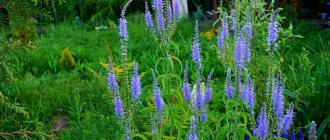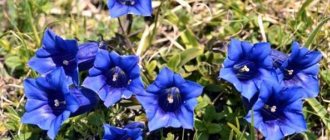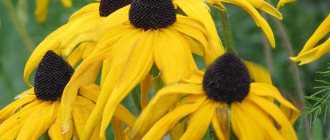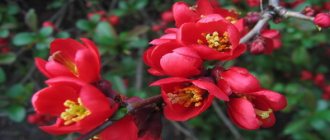Scientific name: Veronica teucrium, Veronica teucrium
Synonyms: Veronica austriaca ssp. teucrium
Family: Scrophulariaceae
Life form: perennial grass
Dimensions: 15 – 100 cm
Flowering time: May - July
Habitat: forest meadows, forest edges, shrubs, light forests.
Description of the plant
The genus Veronica is very diverse and includes inconspicuous, creeping herbaceous plants, tough perennials and large shrubs, so there is plenty to choose from. The plant belongs to the plantain family (Plantaginaceae). In its natural environment it is found throughout almost all of Europe and Asia, in regions with temperate climates. This is a popular garden plant in our country. Most speedwells are unpretentious and easy to grow, suitable even for novice gardeners.
The Latin name was given to the plant in 1542 by the German botanist Leonard Fuchs in honor of Saint Veronica. Veronica also has many other names, including folk ones - snake, Andreev's grass, plakun-grass, snake grass, cyanosis, goat's muzzle.
The genus Veronica contains more than 250 species with different needs and appearance and is widespread in many regions of the Northern Hemisphere. Depending on the type, plants can reach a height of 10 to 200 cm. Variegated flowers can grow singly in the axils of the leaves or form loose or dense clusters. Flowering times also differ from one species to another:
- high varieties bloom in July and remain until frost;
- low – from spring to late summer.
Speedwells are valuable honey plants.
Literature
- Flora of the USSR: in 30 volumes / started at hand. and under chap. ed. V. L. Komarova. — M.—L. : Publishing House of the USSR Academy of Sciences, 1955. - T. XXII / ed. volumes B.K. Shishkin, E.G. Bobrov. - pp. 434-435. — 861 p. — 3000 copies.
- Elenevsky A. G.
[herba.msu.ru/shipunov/school/sch-ru.htm Systematics and geography of speedwells of the USSR and adjacent countries]. - M.: Nauka, 1978. - P. 139-142. — 259 p. - Gubanov, I. A. et al.
1187.
Veronica teucrium
L. - Broad-leaved speedwell // [herba.msu.ru/shipunov/school/books/gubanov2004_illustr_opred_rast_sred_rossii_3.djvu Illustrated guide to plants of Central Russia. In 3 t]. — M.: Scientific T. ed. KMK, Institute of Technology. research, 2004. - T. 3. Angiosperms (dicotyledonous: dicotyledonous). - P. 220. - ISBN 5-87317-163-7.
Landing
Growing conditions
Veronica spica is not only a spectacular and beautifully flowering perennial, but also easy to grow. Basically, it only needs a sunny place, it is soil tolerant. Can grow in any regular garden soil as long as it is not too heavy or wet. It tolerates temporary droughts much better than floods. Prefers weaker and well-drained soils because this is when it blooms most profusely. Grows vigorously in fertile soil but produces fewer flowers.
The best soils for tall varieties of speedwell:
- fertile;
- humus;
- wet;
- loams.
Low varieties prefer soils:
- dry,
- sandy,
- well drained.
The 30-centimeter silver Veronica spicata Silberteppich loves such dry soils. Blooming in May, V. gentianoides (Veronica gentianoides) loves moist soil. V. flowing (Veronica beccabunga) demonstrates completely different tastes; it readily grows on the banks of streams or garden ponds in shallow water. Spike speedwell loves calcareous soils; the substrate must have a high pH, but can grow well when planted in neutral or even slightly acidic soil.
The plant does not like stagnant water, so before planting it is worth mixing the soil intended for its cultivation with sand. Additionally, drainage can be done.
Landing
Plants can be planted all year round, but the best time to plant veronica is mid-May.
Depending on the individual needs of each species, compost should be added to the planting site or gravel or sand drainage should be provided.
Planting pattern:
- The recommended distance for planting is 4-5 pieces per 1 m².
- Plants are placed at intervals of 30-40 cm.
Veronica: types
Veronicastrum
Veronicastrum virginica (Veronicastrum virginica, syn. Veronica virginica, Leptandra virginica). Stems 130-150 cm high are covered with lanceolate leaves, ending in spike-shaped inflorescences over 15 cm long. Blooms from June to August. Varieties differ in bush height, inflorescence length and flower color. It can be white, pink, blue. Good in natural flower beds.
Veronicastrum sibirica (Veronicastrum sibirica, syn. Veronica sibirica, Leptandra sibirica). The plant has strong, non-branching stems 40-150 cm tall. The spike-shaped inflorescence reaches 30 cm in length. Flower color is blue, pink or white. Blooms from June to August.
Speedwell Long-leaved speedwell (Pseudolysimachion longifolia, syn. Veronica longifolia) has a long rhizome, stems 30-150 cm tall are covered with opposite or whorled (3-4 pieces) leaves. Raceme inflorescences up to 25 cm long, most often branched, are located on the tops of the stems. The color of the flower in different varieties can be white, pale blue, bright blue, pink. Blooms from July to September.
Gray speedwell (Pseudolysimachion incana, syn. Veronica incana) forms a spreading bush 20-40 cm tall. The broadly-colored opposite leaves, like the stems, have white-tomentose pubescence. Blue flowers are collected in racemes up to 5 cm long. It blooms from the end of July throughout the month. The varieties differ in the richness of the flower color (dark blue, bright blue), the height of the plant and the size of the leaves.
Austrian speedwell (Veronica austriaca) is a plant 30-70 cm tall with sparse pubescence and a cord-like rhizome. Erect stems are covered with opposite pinnately divided or pinnately dissected leaves. Bright blue flowers up to 1 cm in diameter are collected in fairly dense racemes 6-8 cm long, single or in pairs. Blooms in May-July.
Armenian speedwell (Veronica armena). Thin, pubescent ascending or lodging stems 5-10 cm tall become woody from the base. The leaves are unusual - they look like needles up to 1 cm long. Clusters of bluish or lilac flowers appear from the axils of the leaves at the tops of the shoots. Blooms in June-July. Has a pleasant aroma.
Veronica teucrium (Veronica teucrium, syn. Veronica austriaca ssp. teucrium) is distinguished by curly-hairy pubescence of stems, ovoid shape of leaves pubescent below, a flower diameter of 7-9 mm and an inflorescence up to 12 cm long. It blooms for a month from the end of May. The varieties differ in the height of the bush, the color of the flowers (blue, dark blue), there is even a variety with white-variegated leaves.
Branched or bushy (Veronica fruticans). Bushes are cushion-shaped, about 10 cm tall. The stems are covered with leathery leaves and become woody at the base. Bright blue flowers with a reddish ring are collected in racemes. They decorate the plant in June. Veronica gentianoides forms lush bushes up to 30 cm (rarely 45 cm) in height. The underground part is in the form of a short rhizome. At the base of the bush there is a rosette of wintering lanceolate leathery leaves up to 5 cm long. The stems are weakly leafy, ending in loose multi-flowered spike-shaped inflorescences of pale blue flowers with blue veins. The diameter of the corolla is up to 1 cm. It blooms for 2-3 weeks in June. There are varieties with white-edged leaves and white flowers.
Veronica woody , or shoot (Veronica surculosa) forms a mat 4-5 cm high of creeping stems. They are covered with small lanceolate leaves. The pubescence gives the plant a grayish tint. In May-June, dense short spike-shaped pink inflorescences form at the ends of the stems.
Veronica chamaedrys forms compact bushes 10-40 cm tall. Thin stems are covered with rounded leaves with a jagged edge, ending in loose short racemes of rather large flowers, up to 1.5 cm in diameter. They are bright blue or blue with dark veins, often with a noticeable white spot in the center. Blooms in late May – June. The root system is represented by a thin rhizome. As they grow, the shoots bend to the ground, form adventitious roots, and the tops of the stems continue to grow vertically.
Speedwell Caucasian (Veronica caucasica) - differs from the previous species in the size of the bush (15-20 cm in height), pointed lanceolate petals and their bluish color. Speedwell (Veronica anagallis-aquatica) has long, hollow stems up to 80 cm in height. The leaves are broadly lanceolate, up to 8 cm long and 2.5 cm wide. The rhizome is creeping and thick. The flowers are small, up to 5 mm in diameter, pale blue, collected in numerous loose flower clusters, appear from June to August. Good for decorating a pond. Speedwell (Veronica spicata). Spreading bushes up to 40 cm high are crowned with dense branched racemose inflorescences up to 10 cm long. The lower leaves are petiolate, the upper ones are sessile. The color of the flower, depending on the variety, can be bright blue, juicy purple, soft blue, light pink, crimson, cream or white. It blooms from mid-summer for one and a half months. Modern varieties are distinguished by their compact bush size and long flowering; there is a form with silvery leaves and stems.
Veronica grandiflora. Stems creeping, erect. Opposite oval leaves are concentrated near the ground, giving the impression of a rosette. Peduncles up to 10 cm long, ending in few-flowered racemes of blue flowers. Flowering time is July. The plant is covered with soft hairs.
Speedwell (Veronica officinalis). Creeping stems take root at the nodes, thus forming a thick mat up to 10 cm high. The annual growth of shoots is about 20 cm. Ovate leaves up to 3 cm long are pubescent on both sides. Flowers in paired dense racemes formed from the axils of the leaves. Light purple corolla up to 7 mm in diameter. The flowering period extends from July to September. Veronica minuta. The root system is taproot. A dense cushion-shaped bush is formed by thin stems, densely covered with small opposite oval leaves with a serrated edge. The flowers are blue-blue with a white spot in the center, fragrant, collected in dense short racemes. There are forms with lilac and pale blue flowers. Blooms in July, re-blooming is possible. Veronica filiformis. Thin creeping stems take root at the nodes, forming a mat 3-5 cm high. The leaves are small, rounded. The flowers are blue with dark veins, solitary, appearing from the axils of the upper leaves. There are forms with pale blue and white flowers. Blooms from late April to June. A good ground cover plant for damp areas. Easily becomes a weed.
Creeping speedwell (Veronica repens). Forms a dense mat of thin, highly branched shoots. The leaves are oval or lanceolate, shiny, arranged oppositely. The lower leaves often form a rosette, the upper ones turn into bracts. Inflorescences - axillary racemes 2-10 cm long - consist of blue, white or pink flowers 3-4 mm in diameter. Blooms in May-June. Speedwell , or flowing speedwell (Veronica beccabunda). Fleshy long (up to 30 cm) rooting stems are covered with oval opposite leaves with short petioles. Inflorescences-brushes of small blue flowers about 5 mm in diameter are located in the axils of the upper pair of leaves. Blooms from June to August. Used to decorate a pond.
Veronica prostrate, Veronica rupestris - forms a spreading bush up to 10 cm in height, shoots do not take root at the nodes. The root system is taproot. The leaves are lanceolate, up to 2 cm long, on short petioles. The stems and leaves are slightly pubescent, giving them a grayish tint. The plant is winter green. Flowers up to 8 mm in diameter are collected in dense apical racemes up to 5 cm long. The color of the petals can be white, bluish, pink, bluish, light purple. Flowering period is May-July.
Veronica Sakhalinensis (Veronica sachalinensis) is a powerful plant up to 1.5 m tall. The leaves are collected in whorls, and small blue flowers are collected in long (13-20 cm) racemes at the ends of the stems. Blooms in July-August. Veronica Stelleri (Veronica stelleri) forms a small bush up to 25 cm tall. The leaves are ovate with a serrated or serrated edge. Blue-violet flowers up to 8 mm in diameter are collected in a dense short spike-shaped inflorescence. There is a form with pale lilac, almost white flowers. Flowering in July-September. Veronica serpyllifolia. Stems up to 25 cm tall creep and take root at the nodes. Small, up to 1 cm long, rounded leaves cover the stems from bottom to top, gradually turning into bracts. White or bluish flowers up to 4 mm in diameter are collected in loose apical racemes. related is sometimes classified as a similar species . The differences lie in the size of the flower (5-6 mm in diameter), its color (blue, less often white) and the presence of glandular hairs on the axis of the brush. Flowering from late May to early August. Speedwell (Veronica pedincularis) has a dense network of roots that forms a dense turf. Numerous thin stems form a mat 10-15 cm high. The leaves are oblong, burgundy underneath. Fragrant blue flowers with a white center are collected in dense short racemes. It blooms in early to mid-May and blooms for one and a half months. Broadleaf Speedwell (Veronica latifolia). Stems up to 50 cm tall are covered with opposite small oval-shaped leaves, the lower part is pubescent. Flowers of white, blue or blue color are collected in dense inflorescences-tassels 6-7 cm long, located on the tops of the stems in pairs, in the axils of the upper leaves. Blooms in May-June. Veronica Schmidtiana is a compact winter green plant. The underground part is represented by a thin woody rhizome and fibrous roots. The spreading bush is formed by shoots rising to a height of up to 20 cm. The pinnately divided leaves are concentrated at the soil surface. Quite large lilac flowers up to 2 cm in diameter have long stamens with bright yellow anthers. The dense multi-flowered raceme inflorescence reaches 14 cm in length. Blooms in May-June. Subspecies and forms differ in the color of the flower and leaves. Veronica schistosa. The underground part is a long rhizome, the aboveground part is a carpet of leathery, juicy green leaves and stems up to 20-25 cm tall. Throughout the summer it is covered with clusters of pale blue flowers up to 7-8 cm long. Peak flowering occurs in June-July.
Growing and care
Veronica needs minimal care; the plants need watering and fertilizing as needed.
Feeding
Veronica has low fertilizer needs, however, like any flowering plant, it responds well to their application. You can start fertilizing Veronica after 3-4 years, when the plant begins to grow or bloom worse.
During the summer it is worth feeding with mineral fertilizers. In autumn (October) or spring (March), you can spread a 2.5 cm thick layer of rotted compost around the plant, which will additionally protect it from frost.
The plant does not like intensive fertilizers. Too much nitrogen (or moisture) in the soil is the reason why speedwells don't bloom well.
Trimming
Faded speedwell inflorescences must be removed on an ongoing basis in all species, regardless of their height, so that the plant blooms longer. Trimming speedwells to a third of the length of the shoots in the summer will cause the plant to bloom again.
In autumn, the entire plant should be cut 10 cm above the ground to protect it from disease.
Diseases and pests
Speedwells of all types are extremely hardy and are rarely attacked by pests or diseases. In special cases, aphids may appear. Having noticed these pests, we spray with the natural oil preparation Emulpar 940 EC or insecticides: Karate Gold and Mospilan 20 SP.
Sometimes Veronica is affected by powdery mildew, which can be combated with the help of natural preparations such as Bioczos BR (based on garlic extract) and Biosept Active (with grapefruit extract), as well as homemade decoctions from plants: nettle, horsetail, yarrow.
Pest protection
Veronica planting and care photo Veronica surculosa
Due to its natural endurance, Veronica is rarely affected by infections. Waterlogged soil or a shady area of the garden can provoke the appearance of downy mildew (a gray coating on the leaves). For treatment, a fungicidal solution is prepared from the preparations Fitosporin, Alirin-B, Gamair.
Eliminating the diseased plant and treating the flower bed with nematicides will help fight the ring spot virus. The carriers of the virus are nematodes that live in the soil. Yellow, curled foliage is a sign of soil damage by nematodes, and the plants have ring spot.
Among insect pests, you can most often find caterpillars that eat foliage and young shoots. Warming up the soil, timely weeding, and a break in watering will save you from them. Less common are cutworms, moths, and long-whiskered moths, which can be treated with insecticides.
Reproduction
If you do not decide to remove the inflorescences, Veronica will set seeds and produce abundant self-sowing. However, the offspring obtained in this way may not retain the varietal characteristics of the mother plant. If you need a specific variety, it is better to buy seeds from a reliable seller or purchase ready-made seedlings.
Growing from seeds
Veronica seeds can be sown directly into the ground at the end of spring (late May - June) or under film, in a greenhouse at the turn of April and May (in the summer we transplant them to a permanent place). Seeds do not require particularly high temperatures for germination. They will begin to appear in about 2 weeks. When sowing, do not cover the seeds with soil; press them down a little.
Since speedwell seeds are very small, the seedlings should be pricked and the crops in the bed should be pierced so that they do not become too thick (recommended spacing is approximately 25-30 cm).
Propagation by cuttings
You can cut cuttings from shoots, which, after rooting in water or a damp substrate, are planted in a permanent place (before the first winter, it is recommended to sprinkle them, for example, with straw or grass).
Timing for collecting cuttings:
- cuttings of low species are cut in August-September;
- tall - in April-May.
Cuttings should be taken from healthy plants and should be 10 cm long. After removing the lower leaves, dip the tip in rooting agent and then plant. Cuttings should take root within 20-30 days. After rooting, we plant the seedlings in the ground.
Before the first winter, it is recommended to cover them with agrofibre.
Dividing adult plants
Division is carried out in early spring or after flowering (April-June). Typically, division is carried out immediately after digging up the perennial. We divide the plant into parts so that each has several growing points. Then we shorten the leaves and roots and plant the plants in a permanent place in open ground, watering them abundantly.
Determination formula
Genus:
a plant with green leaves and a leafy stem - the corolla is wheel-shaped, almost regular - there are two stamens -
appearance:
inflorescences are only lateral, there are no apical ones - the plants are pubescent - the stem is pubescent evenly on all sides - the leaves are wider than linear - the stems are erect, the calyx is 5-partite, but 1 the tooth is very short,
or 4-parted, see below in the text
- all leaves are whole, serrated - the stems are erect;
leaves with a rounded or heart-shaped base, sessile, glabrous above, pubescent below; corolla up to 15 mm wide, deep blue (not pale)
.
Note: the definition was made according to the determinant, in which speedwell is included in the Norichnikov family; the determination of the genus was made according to Gubanov, the determination of the species - according to Mayevsky.











